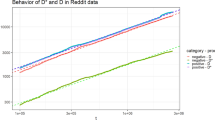Abstract
Cellular Neural Networks (CNNs) constitute a powerful paradigm for modeling complex systems. Innovation systems are complex systems in which small and medium enterprises play the role of simple units interacting with each other. In this paper, innovation systems based on CNN are investigated. It is shown how a model based on CNN can reproduce the main features of innovation systems and how this model can be generalized to include different aspects of the actors of the financial market.
Similar content being viewed by others
References
Allen, P., ‘A complex systems approach to learning in adaptive networks’, International Journal of Innovation Management 5(2), 2001, 149–180.
Chua, L. O. and Yang, L., ‘Cellular Neural Network: Theory’, IEEE Transactions on Circuits and Systems I 35, 1988, 1257–1272.
Chua, L. O., Yang, L., and Roska, T., ‘Cellular Neural Network: Applications’, IEEE Transactions on Circuits and Systems I 35, 1988, 1273–1290.
Chua, L. O. and Roska, T., ‘CNN: The paradigm’, IEEE Transactions on Circuits and Systems I 35, 1993, 147–156.
Watts, D. J., ‘A simple model of global cascades on random networks’, Proceedings of the National Academy of Sciences of United States of America 99, 2002, 5766–5771.
Gladwell, M., The Tipping Point: How Little Things Can Make a Big Difference, Little Brown, New York, 2000.
Bikhchandani, S., Hirshleifer, D., and Welch, I., ‘A Theory of Fads, Fashion, Custom, and Cultural Change as Informational Cascades’, Journal of Political Economy 100(5), 1992, 992–1026.
Strogatz, S. H., Sync: The Emerging Science of Spontaneous Order, Hyperion Press, New York, 2003.
Wolfram, S., Theory and Application of Cellular Automata, World Scientific, Singapore, 1986.
Chua, L. O., Yoon, S., and Dogaru, R., ‘A nonlinear dynamics perspective of Wolfram’s new kind of science. Part I: Threshold of complexity’, International Journal of Bifurcation and Chaos 12(12), 2002, 2655–2766.
Crounse, K. R., Fung, E. L., and Chua, L. O., ‘Efficient implementation of neighbourhood logic for cellular automata via the cellular neural network universal machine’, IEEE Transactions on Circuits and Systems I 44(4), 1997.
Author information
Authors and Affiliations
Corresponding author
Rights and permissions
About this article
Cite this article
Andriani, P., Conti, F., Fortuna, L. et al. Innovation Systems by Nonlinear Networks. Nonlinear Dyn 44, 263–268 (2006). https://doi.org/10.1007/s11071-006-1999-0
Received:
Accepted:
Issue Date:
DOI: https://doi.org/10.1007/s11071-006-1999-0




